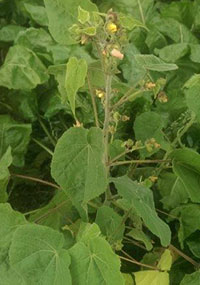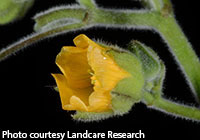Download the velvetleaf farm management factsheet
Download the ‘Ute guide’ for field management of velvetleaf
Background
 Velvetleaf found in Canterbury
Velvetleaf found in Canterbury
Velvetleaf is presenthas been discovered in this season's fodder beet crops on a number of properties throughout New Zealand.
Velvetleaf is a serious cropping weed, potentially affecting many arable crops by competing for nutrients, space, and water. It is an Unwanted Organism in New Zealand.
The current situation has been linked to the importation of contaminated fodder beet seed.
As a consequence, MPI has reviewed its importing rules for seed and strengthened the import requirements for pelletized seed.
Affected seed lines
MPI has been testing imported fodder beet seed lines for velvetleaf contamination. This testing is continuing.
All seed lines that test positive for velvetleaf, an unwanted organism, will not be cleared for entry into New Zealand. Any of these lines that arrive here will either be re-shipped or destroyed.
To date velvetleaf seed has only been found in seed lines sourced from Italy. The imported seed was certified as meeting our biosecurity requirements by Danish authorities. A full list of known contaminated lines follows and will be regularly updated.
A list of fodder beet lines that have tested positive for velvetleaf contamination is as follows. This list will be updated if other lines test positive for velvetleaf.
- Kyros DNK -16UB128
- Bangor DNK-15UB079
- Bangor DNK- 16UB126
- Bangor DNK- 16UB114
- Feldherr DNK-16UB131
- Troya DNK-16UB112
All farmers who have planted fodder beet seed, regardless of the seed line, should check their crops carefully for velvetleaf.
Sightings of this aggressive weed should be reported immediately to MPI on 0800 80 99 66.
Velvetleaf is one of the world's worst cropping weeds, affecting many arable crops by competing for nutrients, space, and water. It is an unwanted organism in New Zealand.
What toBe on the look forout
- Velvetleaf is an annual broad-leaved weed
herbthat grows between 1 and 2.5m tall. - It has buttery-yellow flowers about 3cm across. It flowers from spring through autumn.
- Leaves are large and heart-shaped and are velvety to the touch.
- The plant has distinctive seedpods with 12 to 15 segments in a cup-like ring. Each seedpod is about 2.5cm in diameter.
- At present, most velvetleaf is at the end of its season and is dying, leaves may have dropped and only dark brown/black dried seed heads may remain.
What's being done?done
 Velvetleaf seedpod
Velvetleaf seedpod We know velvetleaf has been present on a small number of properties in the Waikato for a few years, and the regional council is managing it. However, this current fodder beet seed-related situation appears to be recent.
MPI is working with partner organisations to manage velvetleaf. The aim is to find it, contain it, and safely remove any plants found. Your help in finding and reporting this weed will give us the best chance of dealing with it.
What you can do
 Velvetleaf flower
Velvetleaf flower Velvetleaf should be easy to spot among this season's fodder beet plantings. It stands well above the growing beet and looks distinctive. However, in some regions this is not the case because the climate is cooler and it doesn’t grow as quick.
If you have planted fodder beet check your paddocks.fields.
If you find velvetleaf contact MPI on 0800 80 99 66, and then follow these steps:
If the plants have no seeds or if seed pods are green
- Record the location of the plant/s so it is easy to find again for future monitoring.
- Pull out the plant. Bag the full plant – using a large bag (for example fertiliser bag or sack).
- Dispose of the bagged plant/s by deep burial (at least 1m) or in a covered
for example youroffal pit.
If the seed pods have turned black
- Carefully place a large bag (like a fertiliser bag or sack) over the plant’s seed capsules and tie the bag tightly around the stem. It is important to make sure all seed heads are contained within the bag.
- Bend the velvetleaf plant in half so that seeds cannot escape out of the neck of the bag.
- Carefully pull out the plant, bag it again, and dispose of it as described above.
- Inspect the rest of your crop to ensure there are no more plants.
Re-inspection this season
- Keep an eye out for any late emerging velvetleaf plants.
- Re-inspect your field before grazing your fodder beet crop even if your property was inspected for velvetleaf this season.
- If you find plants pull them out, double bag them, and dispose of them as described above.
Our factsheet, 'ute guide'factsheet and velvetleaf farm management plan have more information on what action to take. This includes information about stock grazing, stock movements and managing farm equipment to prevent spreading velvetleaf.
- Read MPI's velvetleaf farm management plan
Download the velvetleaf farm management factsheet - ‘Ute guide’ for field management of velvetleaf
Read MPI's velvetleaf farm management plan - Download the velvetleaf farm management factsheet
Find out more
- Read more about velvetleaf in our pests and diseases database
- Read the latest media release - 26 May 2016
Who to contact
Farmers finding it difficult to deal with the added stress of the velvetleaf incursion are encouraged to call theiryour Rural Support Trust on 0800 787 254 (0800 RURAL HELP) for a free, confidential chat.
MPI and regional councils,Environment Canterbury, Otago Regional Council, Federated Farmers, Foundation for Arable Research, New Zealand Grain and Seed Trade Association, DairyNZ and Beef+Lamb New Zealand thank you for your help in this important work.
If you have questions about velvetleaf, email info@mpi.govt.nz .